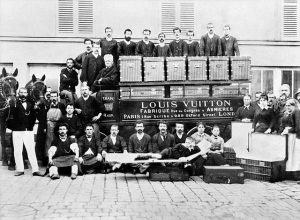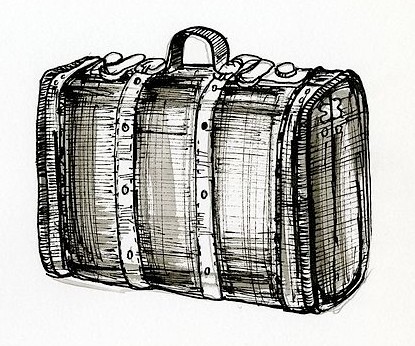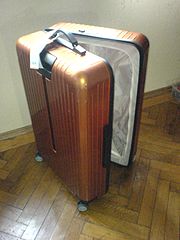
Packing for a well-deserved holiday can be stressful, depending on the length of the trip and the expected activities. If all you need is a couple swimsuits, shorts, T-shirts, and maybe a long skirt for evening, there’s no problem fitting everything into a carry-on bag. But if the journey requires business casual as well as relaxation wear, it becomes more difficult to cram everything into a suitcase that fits into an overhead bin. Who could blame you if you wished for a more spacious piece of luggage. Perhaps something like this?

It won’t fit in the overhead bin, and you don’t really want to carry it into the airport, but it is a reminder of days gone by when people didn’t carry their own luggage, and traveled in steamships or by train, and luggage came in more luxurious forms.

There was a piece of luggage known as a wardrobe trunk. One model by the Mendel-Decker Company of Cincinnati, Ohio was nicknamed “the Aristocrat of Luggage.” The 1930’s trunk stood upright and opened vertically. It had an enclosed compartment where clothing was packed on hangers, and drawers for shirts, shoes, accessories, and anything else. Sometimes the wardrobe included a side piece for hats. The wardrobe protected its contents with interior dust curtains and sturdy bolts and locks to keep the contents safe from elements and thieves.

Louis Vuitton remains the most famous purveyor of luxury traveling cases. When Vuitton opened his business in 1854, trunks had rounded tops so water would run off the surface, but they couldn’t be stacked.

Vuitton introduced flat topped trunks in 1858. The Trianon flat top trunk had a canvas cover to protect the contents from moisture. And the trunks themselves could be easily stacked.

Not everyone needed, wanted, or could afford, a wardrobe trunk. The trunks were excellent for steamship travel, but a bit bulky for the railway. Entrepreneurs introduced the suitcase design in the late 19th century. They featured an inner sleeve for shirts, but were designed for suits. Exterior surfaces were made from leather, wicker, or a thick cloth that stretched over a solid frame of wood or steel. They weren’t lightweight, but by the 1920s, the suitcase symbolized both mobility and adventure.

Luggage in the 21st century lacks the romance of a wardrobe trunk, but can be managed by one person. And there are waterproof, fully lined, polycarbonate cases that can stand up to airline baggage compartments. Sometimes you have to think outside the luggage bin and pack what you need to take on holiday with you. And if you forget anything, there are probably shops at your destination.
???
Illustrations:
My Cat Takes Over the Suitcase.
Cat Sitting in Antique Luggage
Belber Wardrobe Trunk, 1920
The Customs by Antonio Mancini
Louis Vuitton with Family and Trunks, about 1888
Suitcase
Rimowa Air Salsa
Daniel A. Gross. “The History of the Humble Suitcase.” Smithsonian. May 9, 2014.

Sandra Wagner-Wright holds the doctoral degree in history and taught women’s and global history at the University of Hawai`i. Sandra travels for her research, most recently to Salem, Massachusetts, the setting of her new Salem Stories series. She also enjoys traveling for new experiences. Recent trips include Antarctica and a river cruise on the Rhine from Amsterdam to Basel.
Sandra particularly likes writing about strong women who make a difference. She lives in Hilo, Hawai`i with her family and writes a blog relating to history, travel, and the idiosyncrasies of life.

